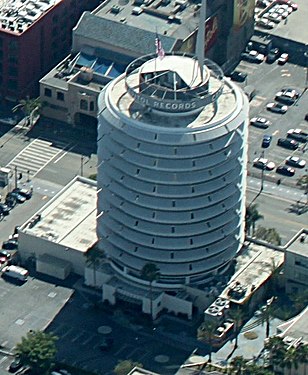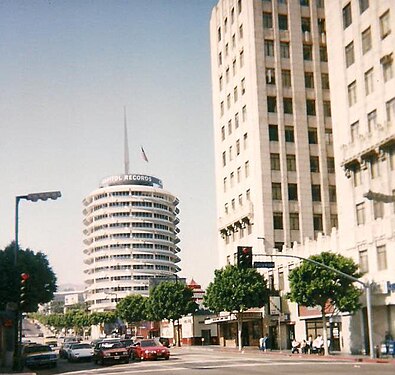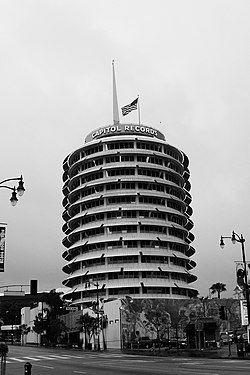Capitol Records Building
| Capitol Records Building | |
|---|---|
 | |
| Alternative names | Capitol Records Tower Capitol Tower |
| General information | |
| Type | Commercial offices |
| Architectural style | Googie architecture |
| Location | 1750 Vine Street Los Angeles, California |
| Coordinates | 34°06′11″N 118°19′34″W / 34.103085°N 118.326189°W / 34.103085; -118.326189Coordinates: 34°06′11″N 118°19′34″W / 34.103085°N 118.326189°W / 34.103085; -118.326189 |
| Construction started | 1955 |
| Completed | 1956 |
| Owner | Argent Ventures |
| Height | |
| Antenna spire | 46 m (151 ft) |
| Technical details | |
| Floor count | 13 |
| Lifts/elevators | 3 |
| Design and construction | |
| Architect | Welton Becket and Associates |
Los Angeles Historic-Cultural Monument | |
| Designated | November 15, 2006 |
| Reference no. | 857 |
| References | |
[1][2][3] | |
The Capitol Records Building, also known as the Capitol Records Tower, is a Hollywood Boulevard Commercial and Entertainment District building that is located in Hollywood, Los Angeles. The building is a thirteen-story tower that was designed by Louis Naidorf (who was working at Welton Becket Associates at the time), and is one of the city's landmarks.[4] Construction occurred soon after British company EMI acquired Capitol Records in 1955, and was completed in April 1956. Located just north of the Hollywood and Vine intersection, the Capitol Records Tower houses the consolidation of Capitol Records' West Coast operations and is home to the recording studios and echo chambers of Capitol Studios. The building is a Los Angeles Historic-Cultural Monument.
Contents
1 Design
1.1 Notable features
1.2 Capitol Studios
2 Recent history
3 In popular culture
4 Gallery
5 References
6 External links
Design
The basis for the building's design is on the graduate school drawings of Lou Naidorf who, as the primary architect, designed the first circular office building when he was twenty-four years old.[5][6] The wide curved awnings over windows on each story and the tall spike emerging from the top of the building resembles a stack of records on a turntable with the spindle pointing skyward.[7] The rectangular ground floor is a separate structure, joined to the tower after completion.
The tower incorporates thirteen stories to conform to the 150-foot (46 m) zoning height limit that was in place at the time of its construction. Height restrictions were lifted in 1956.[8] The thirteenth floor of the tower is the "Executive Level" and is represented by an "E" in the building's two elevators.[citation needed]
Notable features
The blinking light atop the tower spells out the word "Hollywood" in Morse code. This was an idea of Capitol's then-president, Alan Livingston, who wanted to advertise Capitol's status as the first record label with a base on the west coast. Leila Morse activated the switch, granddaughter of Samuel Morse.[7] During the year 1992, the light changed to read "Capitol 50," in honor of the label's fiftieth anniversary.[9] A black-and-white graphic image of the building appeared on the albums of many Capitol recording artists, with the phrase, "From the Sound Capitol of the World".
In April 2011, Capitol Records and artist Richard Wyatt Jr. collaborated to restore his iconic Hollywood Jazz Mural on the south wall of the Capitol Records building.[10]
Restored in hand-glazed ceramic tile, the mural spans 26 by 88 feet (7.9 by 26.8 m)[11] Entitled "Hollywood Jazz: 1945-1972", this masterpiece presents “larger than life” images of a number of notable jazz musicians.
Capitol Studios
The building houses the Capitol Studios, a recording facility which includes eight echo chambers engineered by guitarist Les Paul and three main studios, A, B, and C. Frank Sinatra had a close association with the studios, and the Georg Neumann U 47 microphone he carried around with him is there, often used and maintained for studio sessions. The first album recorded in the tower was Frank Sinatra Conducts Tone Poems of Color. In 2012, Studio A received a new AMS Neve 88R mixing console, designed and built for Al Schmitt and Paul McCartney.[12]
Recent history
In September 2006, EMI sold the tower and adjacent properties for US$50 million to New York developer Argent Ventures. The studio claimed noise from construction of a condominium threatened it, as well as an underground parking lot by building firm Second Street Ventures would have heavy equipment working within 18 feet (5.5 m) of its renowned underground echo chambers, which are themselves over 20 feet (6.1 m) below ground level.[13]
According to the CBS Evening News on July 31, 2008, Second Street Ventures denied this, and the developer's co-owner David Jordon says they had arranged construction work outside the hours of Capitol's recording schedules; he also claimed they have arranged for soundproof materials to be placed between the underground parking lot and Capitol's echo chambers. A senior recording engineer and producer in the recording industry, Al Schmitt, says it would be "heartbreaking" if the company could no longer use the echo chambers, which he says are, "the best in the business."[citation needed]
In November 2012, Steve Barnett was announced as the new Chairman and CEO of the Capitol Music Group and the company stated his office would be in the building.[14]
In popular culture
- The building is known as "The House That Nat Built"[15] due to the vast numbers of records and amounts of merchandise Nat King Cole sold for the company.
- In Earthquake, starring Charlton Heston, an earthquake destroys the building. A clip of this scene is in the pilot episode of Galactica 1980, as Cylon spacecraft fire at the building.
- In the television series Life After People, the building collapses after 175 years without maintenance. The echo chambers underneath the buildings survive for years after the main tower collapses.
- In the 2008 film Hancock, the title character pierces the building's pinnacle with a car in the opening scene.
- In the 2004 film The Day After Tomorrow, a tornado damages the building.
- In the 1990 film The Adventures of Ford Fairlane, the protagonists climb down the outside structure of the building while fleeing the antagonist's henchman.
- In the music video "Closer Than You Know" and "Touch The Sky", Hillsong United performed at the top of the tower.
- In the 1994 arcade game Primal Rage, the building appears in ruins.
- In the 2004 video game Grand Theft Auto: San Andreas, the building appears in the city of Los Santos as the Blastin' Fools Records Building. The building would also appear in Grand Theft Auto V as the Badger Building.
- In the 2005 video game Tony Hawk's American Wasteland, the building appears in the Hollywood level.
Gallery

An aerial view of the Capitol Records Building

Viewed from Hollywood and Vine, 1997

Parking lot mural titled Hollywood Jazz

Taken on 2006-03-28
References
^ Capitol Records Building at Emporis
^ Capitol Records Building at Glass Steel and Stone
^ "Capitol Records Building". SkyscraperPage..mw-parser-output cite.citation{font-style:inherit}.mw-parser-output q{quotes:"""""""'""'"}.mw-parser-output code.cs1-code{color:inherit;background:inherit;border:inherit;padding:inherit}.mw-parser-output .cs1-lock-free a{background:url("//upload.wikimedia.org/wikipedia/commons/thumb/6/65/Lock-green.svg/9px-Lock-green.svg.png")no-repeat;background-position:right .1em center}.mw-parser-output .cs1-lock-limited a,.mw-parser-output .cs1-lock-registration a{background:url("//upload.wikimedia.org/wikipedia/commons/thumb/d/d6/Lock-gray-alt-2.svg/9px-Lock-gray-alt-2.svg.png")no-repeat;background-position:right .1em center}.mw-parser-output .cs1-lock-subscription a{background:url("//upload.wikimedia.org/wikipedia/commons/thumb/a/aa/Lock-red-alt-2.svg/9px-Lock-red-alt-2.svg.png")no-repeat;background-position:right .1em center}.mw-parser-output .cs1-subscription,.mw-parser-output .cs1-registration{color:#555}.mw-parser-output .cs1-subscription span,.mw-parser-output .cs1-registration span{border-bottom:1px dotted;cursor:help}.mw-parser-output .cs1-hidden-error{display:none;font-size:100%}.mw-parser-output .cs1-visible-error{font-size:100%}.mw-parser-output .cs1-subscription,.mw-parser-output .cs1-registration,.mw-parser-output .cs1-format{font-size:95%}.mw-parser-output .cs1-kern-left,.mw-parser-output .cs1-kern-wl-left{padding-left:0.2em}.mw-parser-output .cs1-kern-right,.mw-parser-output .cs1-kern-wl-right{padding-right:0.2em}
^ Christopher Hawthorne (29 May 2011). "Critic's Notebook: Hollywood landmark at a crossroads". Los Angeles Times. Retrieved 18 April 2013.
^ MillenniumHollywood (23 October 2012). "Millennium Hollywood: Lou Naidorf" (Video upload). YouTube. Google, Inc. Retrieved 25 September 2013.
^ Jessica Hundley (16 January 2003). "A star was born". Los Angeles Times. Retrieved 25 September 2013.
^ ab Huell Howser; Sue Satriano (1988). Exploring L.A. with Huell (video). Hollywood, California: KCET. Archived from the original (mp3) on 8 December 2007. Retrieved 22 September 2010.
^ Nathan Masters (23 May 2012). "L.A.'s Changing Skyline: A Brief History of Skyscrapers in the City of Angels". KCET. KCETLink. Retrieved 3 October 2013.
^ MacMINN, ALEENE (1992-05-28). "Pop/rock". Los Angeles Times. ISSN 0458-3035. Retrieved 2016-04-06.
^ "Capitol Records Jazz Mural restored!". Millennium Hollywood. Millennium Hollywood Partners. 30 January 2013. Archived from the original on 2013-05-25. Retrieved 18 April 2013.
^ Randy Lewis (18 February 2013). "'Hollywood Jazz' mural lives on more brightly". Los Angeles Times. Retrieved 18 April 2013.
^ August Brown (1 November 2012). "Capitol Studios". Los Angeles Times. Retrieved 8 October 2014.
^ Bob Pool (June 18, 2008). "Capitol Fears For Its Sonic Signature". Los Angeles Times. p. B2.
^ August Brown (26 November 2012). "Steve Barnett to lead Capitol Music Group". Los Angeles Times. Retrieved 3 October 2013.
^ Congressional Record. Retrieved 24 December 2013.
External links
| Wikimedia Commons has media related to Capitol Records Building. |
- Capitol Studios official website



